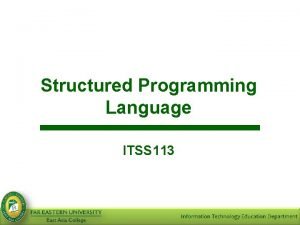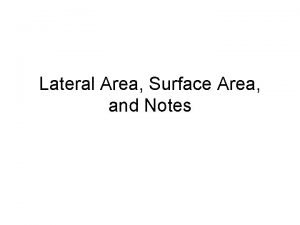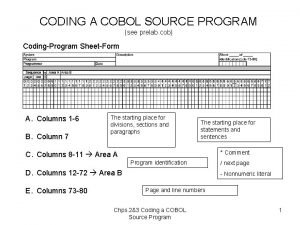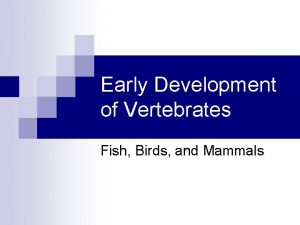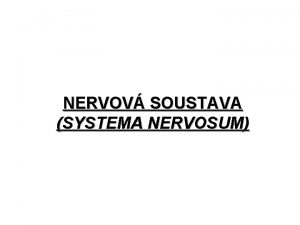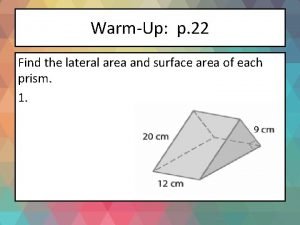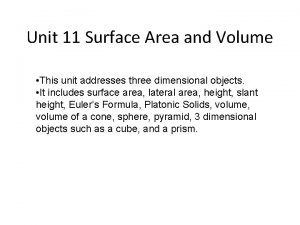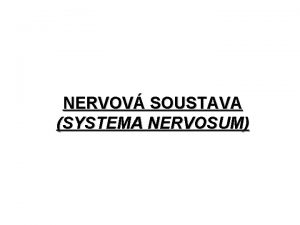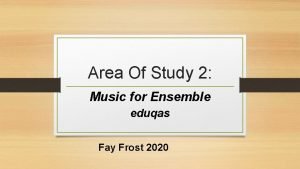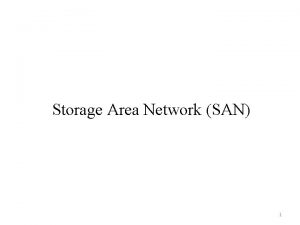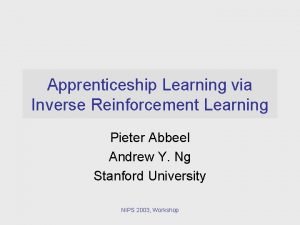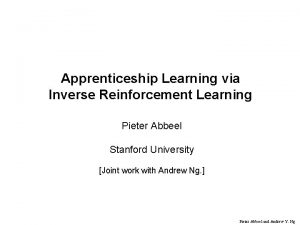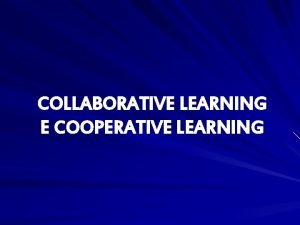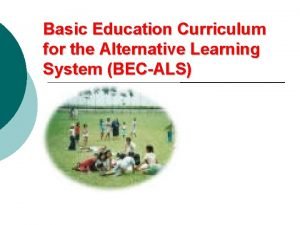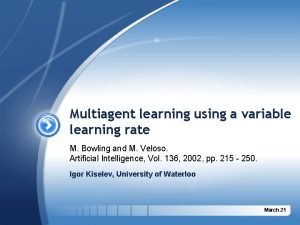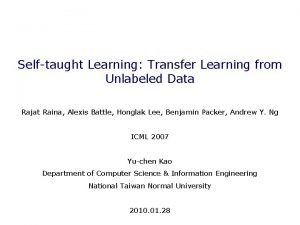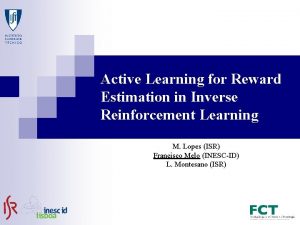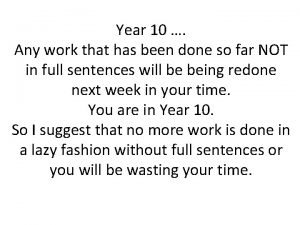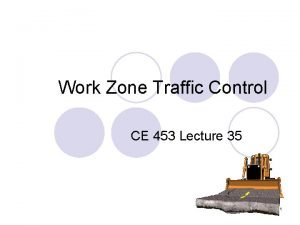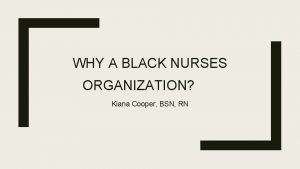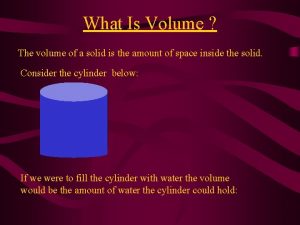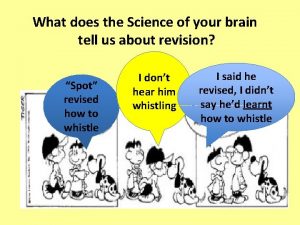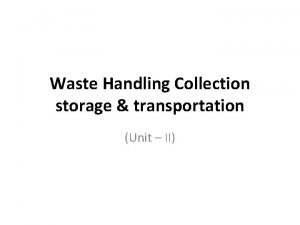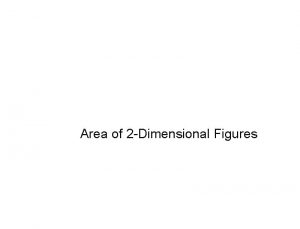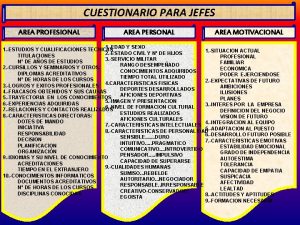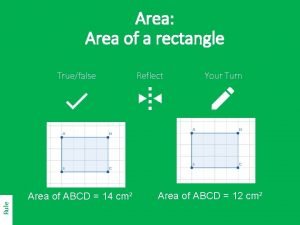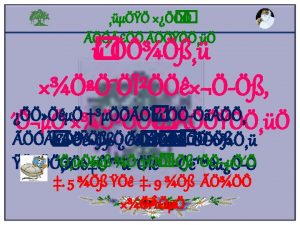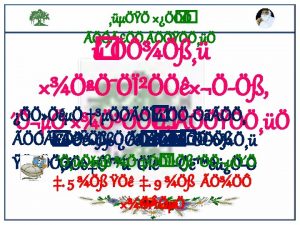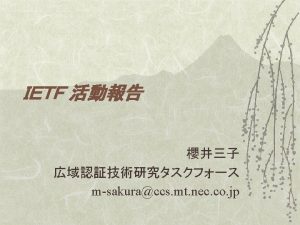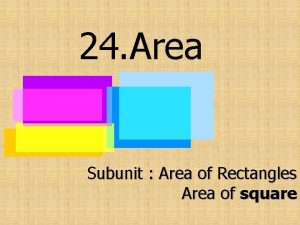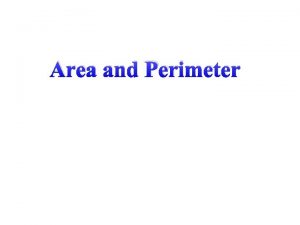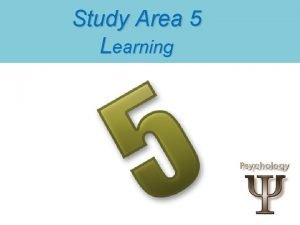Study Area 5 Learning What is Learning Learning






































































- Slides: 70

Study Area 5 Learning

What is Learning? • Learning: any relatively permanent change in behavior brought about by experience or practice – When people learn anything, some part of their brain is physically changed to record what they have learned. – Any kind of change in the way an organism behaves is learning.

Classical Conditioning • Classical conditioning: a learning process that occurs when two stimuli are repeatedly paired; a response that is at first elicited by the second stimulus is eventually elicited by the first stimulus alone.

Pavlov and Classical Conditioning • Ivan Pavlov: Russian physiologist (person who studies the workings of the body) who discovered classical conditioning through his work on digestion in dogs • Classical conditioning: learning to make a reflex response to a stimulus other than the original, natural stimulus that normally produces the reflex

Classical Conditioning Concepts • Unconditioned stimulus (UCS): a naturally occurring stimulus that leads to an involuntary response – unconditioned means “unlearned” or “naturally occurring. ” • Unconditioned response (UCR): (UCR an involuntary response to a naturally occurring or unconditioned stimulus

Classical Conditioning Concepts • Conditioned stimulus (CS): stimulus that becomes able to produce a learned reflex response by being paired with the original unconditioned stimulus – conditioned means “learned” – neutral stimulus (NS) can become a conditioned stimulus when paired with an unconditioned stimulus

Classical Conditioning Concepts • Conditioned response (CR): learned reflex response to a conditioned stimulus – sometimes called a conditioned reflex – CS: ice cream truck – CR: salivation when one hears ice cream truck bell

Classical Conditioning UCS Loud Noise CS Bunny Rabbit UCS Loud Noise UCR Startle

Classical Conditioning UCS Car Crash CS Squealing Brakes UCS Car Crash UCR Racing Heart

Classical Conditioning Before conditioning takes place, the sound of the metronome does not cause salivation and is a neutral stimulus, or NS. During conditioning, the sound of the metronome occurs just before the presentation of the food, the UCS. The food causes salivation, the UCR. When conditioning has occurred after several pairings of the metronome with the food, the metronome will begin to elicit a salivation response from the dog without any food. This is learning, and the sound of the metronome is now a CS and the salivation to the bell is the CR.

Classical Conditioning Concepts • Acquisition: repeated pairing of the NS and the UCS; the organism is in the process of acquiring learning – although classical conditioning happens quite easily, there a few basic principles that researchers have discovered: § CS must come before UCS. Backwards conditioning does not work! § CS and UCS must come very close together in time—ideally, only several seconds apart § neutral stimulus must be paired with the UCS several times, often many times, before conditioning can take place

Classical Conditioning Concepts • CS is usually some stimulus that is distinctive or stands out from other competing stimuli • Stimulus generalization: tendency to respond to a stimulus that is only similar to the original conditioned stimulus with the conditioned response

Strength of the Generalized Response An example of stimulus generalization. The UCS was an electric shock and the UCR was the galvanic skin response (GSR), a measure associated with anxiety. The subjects had been conditioned originally to a CS tone (0) of a given frequency. When tested with the original tone, and with tones 1, 2, and 3 of differing frequencies, a clear generalization effect appeared. The closer the frequency of the test tone to the frequency of tone 0, the greater was the magnitude of the galvanic skin response to the tone (Hovland, 1937).

Classical Conditioning Concepts Discrimination is the ability to differentiate between a learned Stimulus and similar stimuli. • Stimulus discrimination: tendency to stop making a generalized response to a stimulus that is similar to the original conditioned stimulus because the similar stimulus is never paired with the unconditioned stimulus

Classical Conditioning Concepts • Extinction: disappearance or weakening of a learned response following the removal or absence of the unconditioned stimulus (in classical conditioning) or the removal of a reinforcer (in operant conditioning)

Classical Conditioning Concepts • Spontaneous recovery: reappearance of a learned response after extinction has occurred – learning is a relatively permanent change in behavior • Higher-order conditioning 1. strong conditioned stimulus is paired with a neutral stimulus 2. neutral stimulus becomes a seconditioned stimulus

Extinction and Spontaneous Recovery

Higher-Order Conditioning

Conditioned Emotional Response • Conditioned emotional response (CER): emotional response that has become classically conditioned to occur to learned stimuli – examples: fear of dogs; the emotional reaction that occurs when seeing an attractive person – CERs may lead to phobias—irrational fear responses.

Conditioning of “Little Albert” After “Little Albert” had been conditioned to fear a white rat, he also demonstrated fear to a rabbit, a dog, and a sealskin coat (although it remains uncertain if stimulus generalization actually occurred as this fear was to a single rabbit, a single dog, etc. ). Can you think of any emotional reactions you experience that might be classically conditioned emotional responses?


Classical Conditioning UCS Dog Bite CS Sight of Dog UCS Dog Bite UCR Frightened

Classical Conditioning Higher-order UCS Kiss CS Sight of Significant Other UCS Kiss UCR Racing Heart

Taste Aversion • Vicarious conditioning: classical conditioning of a reflex response or emotion by watching the reaction of another person • Conditioned taste aversion: development of a nausea or aversive response to a particular taste because that taste was followed by a nausea reaction – occurs after only one association

Taste Aversion • Biological preparedness: the tendency of animals to learn certain associations, such as taste and nausea, with only one or few pairings due to the survival value of the learning • Biological preparedness is the idea that people and animals are inherently inclined to form associations between certain stimuli and responses. • Some associations form easily because we are predisposed to form such connections, while other associations are much more difficult to form because we are not naturally predisposed to form them. • For example, it has been suggested that biological preparedness explains why certain types of phobias tend to form more easily. We tend to develop a fear of things that may pose a threat to our survival, such as heights, spiders, and snakes. Those who learned to fear such dangers more readily were more likely to survive and reproduce.

Why Classical Conditioning Works? • Stimulus substitution: original theory in which Pavlov stated that classical conditioning occurred because the conditioned stimulus became a substitute for the unconditioned stimulus by being paired closely together

Why Classical Conditioning Works? • Cognitive perspective: modern theory in which classical conditioning is seen to occur because the conditioned stimulus provides information or an expectancy about the coming of the unconditioned stimulus

Operant Conditioning • Operant conditioning: the learning of voluntary behavior through the effects of pleasant and unpleasant consequences to responses Intro 1 Intro 2 Intro 3 Intro 4

Operant Conditioning • Operant conditioning (a. k. a. "instrumental conditioning") is a type of learning in which (a) the strength of a behavior is modified by the behavior's consequences, such as reward or punishment, and (b) the behavior is controlled by antecedents called "discriminative stimuli" which come to signal those consequences. • The discriminative stimulus is the cue (stimulus) that is present when the behavior is reinforced. The animal learns to exhibit the behavior in the presence of the discriminative stimulus.

Operant Conditioning • Thorndike’s law of effect (1905) – if a response is followed by a pleasurable consequence, it will tend to be repeated – if a response is followed by an unpleasant consequence, it will tend not to be repeated Edward Thorndike had a powerful impact on reinforcement theory and behavior analysis, providing the basic framework for empirical laws in behavior psychology.

Graph of the Time to Learn in Thorndike’s Experiment This is one of the earliest “learning curves” in the history of the experimental study of conditioning. The time required by one of Thorndike’s cats to escape from the puzzle box gradually decreased with trials but with obvious reversals.

Skinner’s Contribution • Skinner was a behaviorist; he wanted to study only observable, measurable behavior • Gave “operant conditioning” its name – operant: any behavior that is voluntary • Learning depends on what happens after the response: the consequence

Figure 5. 7 A Typical Skinner Box This rat is learning to press the bar in the wall of the cage in order to get food (delivered a few pellets at a time in the food trough on lower left). In some cases, the light on the top left might be turned on to indicate that pressing the bar will lead to food or to warn of an impending shock delivered by the grate on the floor of the cage.

Reinforcement • Reinforcement: any event or stimulus, that when following a response, increases the probability that the response will occur again – primary reinforcer: any reinforcer that is naturally reinforcing by meeting a basic biological need, such as hunger, thirst, or touch – secondary reinforcer: any reinforcer that becomes reinforcing after being paired with a primary reinforcer, such as praise, tokens, or gold stars

Positive and Negative Reinforcement • Positive reinforcement: the reinforcement of a response by the addition or experience of a pleasurable stimulus • Negative reinforcement: the reinforcement of a response by the removal, escape from, or avoidance of an unpleasant stimulus – example: taking aspirin for a headache is negatively reinforced: removal of headache!


Schedules of Reinforcement • Partial reinforcement effect: a response that is reinforced after some—but not all— correct responses tends to be very resistant to extinction • Continuous reinforcement: reinforcement of each and every correct response

Schedules of Reinforcement • Fixed interval schedule of reinforcement: interval of time that must pass before reinforcement becomes possible is always the same • Variable interval schedule of reinforcement: the interval of time that must pass before reinforcement becomes possible is different for each trial or event

Schedules of Reinforcement • Fixed ratio schedule of reinforcement: number of responses required for reinforcement is always the same • Variable ratio schedule of reinforcement: schedule of reinforcement in which the number of responses required for reinforcement is different for each trial or event

Schedules of Reinforcement

Schedules of Reinforcement These four graphs show the typical pattern of responding for both fixed and variable interval and ratio schedules of reinforcement. The responses are cumulative, which means new responses are added to those that come before, and all graphs begin after the learned pattern is well established. Slash marks mean that a reinforcement has been given. In both the fixed interval and fixed ratio graphs, there is a pause after each reinforcement as the learner briefly “rests. ” The “scalloped” shape of the fixed interval curve is a typical indicator of this pause, as is the stair-step shape of the fixed ratio curve. In the variable interval and ratio schedules, no such pause occurs, because the reinforcements are unpredictable. Notice that both fixed and variable interval schedules are slower (less steep) than the two ratio schedules because of the need to respond as quickly as possible in the ratio schedules.

Punishment • Punishment: any event or object that, when following a response, makes that response less likely to happen again • Punishment by application: the punishment of a response by the addition or experiencing of an unpleasant stimulus • Punishment by removal: the punishment of a response by the removal of a pleasurable stimulus



Problems with Punishment • Severe punishment – may cause avoidance of the punisher instead of the behavior being punished – may encourage lying to avoid punishment – creates fear and anxiety

How to Make Punishment More Effective 1. Punishment should immediately follow the behavior it is meant to punish. 2. Punishment should be consistent. 3. Punishment of the wrong behavior should be paired, whenever possible, with reinforcement of the right behavior.

Operant Stimuli and Stimulus Control • Discriminative stimulus: any stimulus, such as a stop sign or a doorknob, that provides the organism with a cue for making a certain response in order to obtain reinforcement

Operant Stimuli and Stimulus Control • Shaping: reinforcement of simple steps, leading to a desired complex behavior • Successive approximation: small steps, one after another, that lead to a particular goal behavior

Operant Stimuli and Stimulus Control • Extinction occurs if the behavior (response) is not reinforced. • One way to deal with a child’s temper tantrum is to ignore it; lack of reinforcement for the tantrum behavior will eventually result in extinction • Operantly conditioned responses also can be generalized to stimuli that are only similar—not identical—to the original stimulus

Operant Stimuli and Stimulus Control • Spontaneous recovery (reoccurrence of a once-extinguished response) also happens in operant conditioning

Behavior Resistant to Conditioning • Instinctive drift: tendency for an animal’s behavior to revert to genetically controlled patterns – Each animal comes into the world (and the laboratory) with certain genetically determined instinctive patterns of behavior already in place. – These instincts differ from species to species. – There are some responses that simply cannot be trained into an animal regardless of conditioning.

Behavior Resistant to Conditioning • Raccoons commonly dunk their food in and out of water before eating. This “washing” behavior is controlled by instinct, and is difficult to change even using operant techniques.

Behavior Modification • Behavior modification: use of operant conditioning techniques to bring about desired changes in behavior • Token economy: type of behavior modification in which desired behavior is rewarded with tokens

Behavior Modification • Time-out: form of mild punishment by removal in which a misbehaving animal, child, or adult is placed in a special area away from the attention of others – essentially, the organism is being “removed” from any possibility of positive reinforcement in the form of attention

Behavior Modification • Applied behavior analysis (ABA): modern term for a form of behavior modification that uses shaping techniques to mold a desired behavior or response • Applied behavior analysis is the process of systematically applying interventions based upon the principles of learning theory to improve socially significant behaviors to a meaningful degree, and to demonstrate that the interventions employed are responsible for the improvement in behavior (Baer, Wolf & Risley, 1968

Biofeedback and Neurofeedback • Biofeedback: use of feedback about biological conditions to bring involuntary responses such as blood pressure and relaxation under voluntary control • Neurofeedback: form of biofeedback using devices (EEG, f. MRI) to provide feedback about brain activity in an effort to modify behavior

Cognitive Learning Theory • In the early days of learning, researchers’ focus was on behavior. • In the 1950 s—and more intensely in the 1960 s—many psychologists were becoming aware that cognition, the mental events that take place inside a person’s mind while behaving, could no longer be ignored.

Latent Learning • Latent learning is a form of learning that is not immediately expressed in an overt response; it occurs without any obvious reinforcement of the behavior or associations that are learned. • Edward Tolman: early cognitive scientist – best-known experiments in learning involved teaching three groups of rats the same maze, one at a time (Tolman & Honzik, 1930 b)

Latent Learning • Edward Tolman’s Maze Experiment – Group 1 § rewarded each time at end of maze § learned maze quickly – Group 2 § in maze every day; only rewarded on 10 th day § demonstrated learning of maze almost immediately after receiving reward – Group 3 § never rewarded § did not learn maze well

A Typical Maze This is an example of a maze such as the one used in Tolman’s experiments in latent learning. A rat is placed in the start box. The trial is over when the rat gets to the end box.

Latent Learning • Latent learning: learning that remains hidden until its application becomes useful.

Learning Curves for Three Groups of Rats In the results of the classic study of latent learning, Group 1 was rewarded on each day, while Group 2 was rewarded for the first time on Day 11. Group 3 was never rewarded. Note the immediate change in the behavior of Group 2 on Day 12 (Tolman & Honzik, 1930).

Insight - Kohler Cognitive Learning Theory • Insight: the sudden perception of relationships among various parts of a problem, allowing the solution to the problem to come quickly – cannot be gained through trial-and-error learning alone – “Aha” moment

Learned Helplessness: Seligman Cognitive Learning Theory • Learned helplessness: tendency to fail to act to escape from a situation because of a history of repeated failures in the past • Positive psychology: new(? ) way of looking at the entire concept of mental health and therapy that focuses on the adaptive, creative, and psychologically more fulfilling aspects of human experience rather than on mental disorders

Seligman’s Apparatus In Seligman’s studies of learned helplessness, dogs were placed in a two-sided box. Dogs that had no prior experience with being unable to escape a shock would quickly jump over the hurdle in the center of the box to land on the “safe” side. Dogs that had previously learned that escape was impossible would stay on the side of the box in which the shock occurred, not even trying to go over the hurdle.

Observational Learning: Bandura • Observational learning: learning new behavior by watching a model perform that behavior it is a type of learning most associated with the work and social learning theory of psychologist Albert Bandura. Observational learning is thought to be particularly important during childhood. • Learning/performance distinction: learning can take place without actual performance of the learned behavior

Bandura’s Bobo Doll Experiment In Albert Bandura’s famous Bobo doll experiment, the doll was used to demonstrate the impact of observing an adult model performing aggressive behavior on the later aggressive behavior of children. The children in these photos are imitating the adult model’s behavior even though they believe they are alone and are not being watched.

Four Elements of Observational Learning • Attention – To learn anything through observation, the learner must first pay attention to the model. • Memory – The learner must also be able to retain the memory of what was done, such as remembering the steps in preparing a dish that were first seen on a cooking show. • Imitation – The learner must be capable of reproducing, or imitating, the actions of the model.

Four Elements of Observational Learning • Motivation – The learner must have the desire to perform the action. In terms of Consumer Learning

The End – Study Area 5 Learning
 Lateral suface area
Lateral suface area Cobol area a and area b
Cobol area a and area b Cobol area a and area b
Cobol area a and area b Volume and surface area of cone
Volume and surface area of cone Lateral surface
Lateral surface Cobol area a and area b
Cobol area a and area b Anterior posterior axis
Anterior posterior axis Segmentová inervace těla
Segmentová inervace těla Surfce area
Surfce area Mandibular impression landmarks
Mandibular impression landmarks Lateral edge
Lateral edge Lateral surface
Lateral surface Pns divisions
Pns divisions Segmentová inervace těla
Segmentová inervace těla Definition of lateral area
Definition of lateral area Lateral area of a hexagonal prism
Lateral area of a hexagonal prism Masteringmicrobiology study area
Masteringmicrobiology study area Www.masteringbio.com
Www.masteringbio.com Study area in project
Study area in project Area of study 2
Area of study 2 San storage architecture diagram
San storage architecture diagram Nasht
Nasht Related texts for area of study discovery
Related texts for area of study discovery Ecological study vs cohort study
Ecological study vs cohort study Retrospective cohort study
Retrospective cohort study Work study technique
Work study technique Study less study smart
Study less study smart Phytogeographical regions
Phytogeographical regions Work study objectives
Work study objectives Distinguish between time study and motion study
Distinguish between time study and motion study Cuadro comparativo de e-learning b-learning y m-learning
Cuadro comparativo de e-learning b-learning y m-learning Objectives of case study
Objectives of case study Lda supervised or unsupervised
Lda supervised or unsupervised Concept learning task in machine learning
Concept learning task in machine learning Analytical learning in machine learning
Analytical learning in machine learning Associative learning
Associative learning Remarks on lazy and eager learning
Remarks on lazy and eager learning What is conceptual learning
What is conceptual learning Difference between inductive and analytical learning
Difference between inductive and analytical learning Apprenticeship learning via inverse reinforcement learning
Apprenticeship learning via inverse reinforcement learning Apprenticeship learning via inverse reinforcement learning
Apprenticeship learning via inverse reinforcement learning Difference of inductive and deductive reasoning
Difference of inductive and deductive reasoning Pac learning model in machine learning
Pac learning model in machine learning Perbedaan supervised dan unsupervised learning
Perbedaan supervised dan unsupervised learning Pac learning model in machine learning
Pac learning model in machine learning Inductive and analytical learning
Inductive and analytical learning Instance based learning in machine learning
Instance based learning in machine learning Inductive learning machine learning
Inductive learning machine learning First order rule learning in machine learning
First order rule learning in machine learning Collaborative learning vs cooperative learning
Collaborative learning vs cooperative learning Alternative learning system learning strands
Alternative learning system learning strands Passive learning vs active learning
Passive learning vs active learning Multiagent learning using a variable learning rate
Multiagent learning using a variable learning rate Cmu machine learning
Cmu machine learning Deep learning approach and surface learning approach
Deep learning approach and surface learning approach Self-taught learning: transfer learning from unlabeled data
Self-taught learning: transfer learning from unlabeled data Active learning reinforcement learning
Active learning reinforcement learning Urban area meaning
Urban area meaning It is a very shallow skillet with very short sloping sides
It is a very shallow skillet with very short sloping sides Termination area mutcd
Termination area mutcd Work area protection manual
Work area protection manual Mobile wide area network
Mobile wide area network Regional area network
Regional area network What is wawf
What is wawf Bay area black nurses association
Bay area black nurses association Solid
Solid 531 area code
531 area code Gynaecology ninewells
Gynaecology ninewells Hazleton area academy of sciences
Hazleton area academy of sciences Soils in ____ contain little organic material and are thin.
Soils in ____ contain little organic material and are thin. Bmw storage area
Bmw storage area

